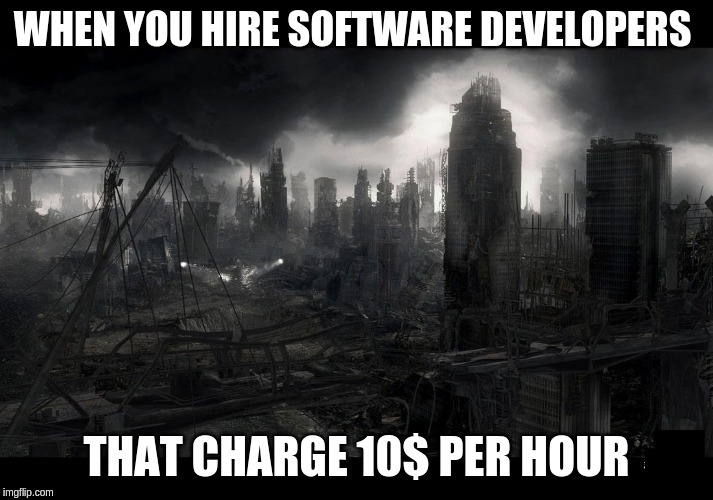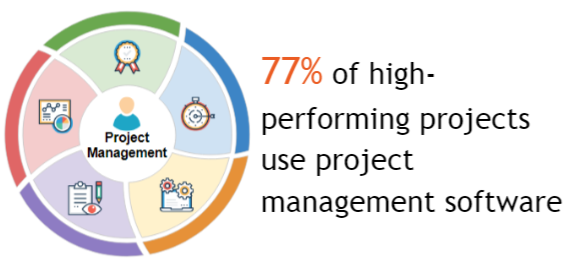According to a report by CodingSanS, 12.37% of managers believe wrong estimations are the #1 cause of delivery problems for a software development company. When the estimated time and cost are wrongly calculated, everything takes a setback. Bespoke software quality, trust over the software development team, time to market, everything fails.
Source: Harvard Business Review
Sometimes these IT failures are so drastic, it can completely tear apart your software. Mckinsey points out that 17% of IT projects go so bad that they can threaten the very existence of the company.” But, let me tell you it’s actually not that hard to make sure your software company sticks to the custom software application development time and budget that was committed to you. In this article, we talk about a few pivotal things that everyone should follow in order to ensure their software development costs and time doesn’t overrun.
Step 1: Hire software developers that are competent
This goes without saying that your software is as good as the software company you hire. Most of the time, deadlines and budget go out of hand because of wrong hiring decisions and little to no involvement with the project. Let me explain with these 2 scenarios :
Scenario 1: You have a list of well-researched potential firms. You get with them on a call and discuss a bit about your company and try to know a bit about theirs. You tell them your idea, discuss the features in detail and then ask them for an estimate.
Scenario 2: You have a list of the cheapest firms. You get with them on a call and very briefly give them an idea of your software. Before they can comprehend the details, you ask them for an estimate.
Now, the difference here is, in the second scenario, the chances of your software project turning into a disaster is much higher than the first scenario. This is because, the first firm got the time to understand the requirements, could engage their architects to analyze the project properly, make a proper BRD(Business Requirement Document) to bring both parties on the same page and then make a well informed estimate about the time and money required for the project.
The second firm will probably just nod yes to whatever you ask for and give you an estimate that will be more towards pleasing you rather than reflecting the actual effort of the project. You will also be probably happy because the estimate they will provide is 1/4th of the first one. You might initially think everything worked out so well and so fast.
But the real nightmare will start when the development company brings up the fact that the project requirement is much higher than initially thought to be and the estimated cost and time is no longer sufficient. Even worse if they somehow finish the project with low quality code and cutting many corners and the software collapses in production with your valuable customers resulting in destroying your business may be.
Make sure you have some proper criteria to judge the software providers and price is probably not the sole or most important criteria if you are looking for serious business. If you want to know more about how to hire the right software development company, we have a detailed article for the same.
Read more: How to reduce software development costs?
Step 2: Know what you are building
Software development is somewhat like building a house. You first need to have a plan and then start with building blocks. You need to make sure everything is in place and visualize all the components and elements.
For this purpose, we recommend you start by putting your ideas on paper. Nobody knows your business better than you and thus, nobody will know the requirements better either. Once you have a vision and the features you need, ask your software company to draft a Business Requirement Document (BRD) or if you have time do it yourself.
A BRD is a list of the critical features that the software requires to meet the organizational objectives of the client. It is recommended that your software development company documents each and every feature, functionality and end-to-end process flow. They must also document the features that were asked by the client but was later deemed inappropriate for the time being.
This helps to keep a tab on the time and cost. Generally, the cost and time estimates are based on this document. Keep in mind, the more fleshed out this stage will be, the more precise the time estimation will be.
A focused and detailed BRD will help keep your time as well as cost estimates in check. It acts as an informal contract that you can always go back to in case of conflicts or disputes.
Read more: How to estimate software development time?
Step 3: Get a project manager as SPOC
A project manager’s responsibility is to ensure that the software development process works as it is intended. This is one step most of the clients take for granted. Make sure you have one person that is assigned to you as your single point of contact.
Source: Workamajig
A project manager should be accomplished in initiating, planning, executing, monitoring and controlling, and closing software throughout the complete software development life cycle. They will work with both the development team as well as the business stakeholders in order to ensure that the final software product matches the customer expectations and is completed within the expected time frame.
Having a project manager brings along the assurance that you have a single point of contact who is aware of every aspect of your project. He/she will continuously oversee the software, communicate with you, and make sure it is completed within the committed time and budget.
STEP 4: Communicate and stay involved
It is “great communication” that allows business stakeholders sitting at one end and a custom software application development company at the other end to work together. All competent companies that provide custom software development services have a set of processes in place to ensure that the clients stay updated on the project’s progress.
BinaryFolks leverage a multi-mode communication channel(video calls, screen sharing, email etc.), cutting across multiple time-zone barriers in order to simulate a local office environment with the clients.
Another aspect that is important to point out is keeping oneself involved with the project. Knowing what’s happening and what’s the progress of the project once a week encourages better management.
But, this doesn’t mean that one needs to micromanage everything. You don’t need to dig your fingers deep into the pie of those actually doing the work. With micromanagement, the skills, and insights of the software company that you hire can fall to the wayside, leaving you with a team that only knows how to do what it's told.
STEP 5: Testing
We can’t stress enough about the importance of testing. Rigorous testing not only helps improve the quality, reliability & performance of the system but also helps save costs.
Source: Harvard Business Review
Make testing a priority from the very first day, even if it is manual testing. Errors and bugs often start creeping into the software during the initial phases and then start manifesting eventually. Testing should be introduced in the early stage of the SDLC as the cost incurred to fix issues at the early stage would be less than what you have to spend to fix bugs that are found after the complete development is over.
In conclusion
According to PMI, project performance has been rising globally. In 2018, nearly 70% of projects met their original goals or business intent, while nearly 60% were completed within the original budget. Successfully developing custom software requires a crystal clear understanding of the software requirements and collaboration. Establishing communication, trust, and constant feedback helps both you and your software provider to have a better chance of succeeding in this game of custom software application development.



.png)

.png)